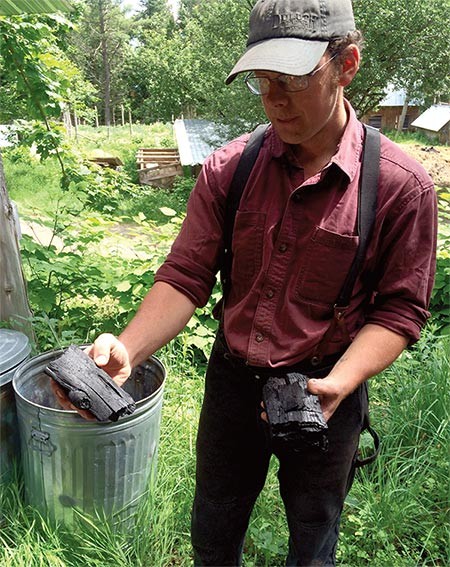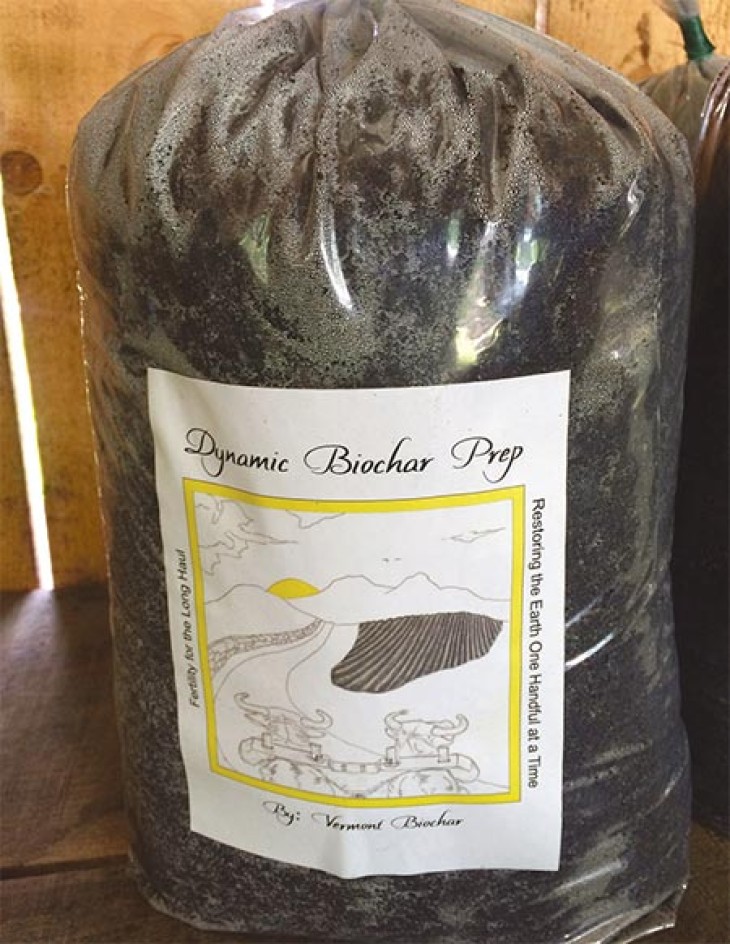Michael Low knows intimately every footstep of his 67-acre Green Fire Farm. He has worked this land for a dozen years, and his wife and business partner, Hart Brent, has been here a decade longer, tending the old hill farm on the Bayley-Hazen Road in Peacham, Vermont, a place, like so many in this region, that has been largely reforested.
On one part of the farm, a recently reclaimed pasture, now thick in clover, has been attracting regular visits from wandering deer. Nearby, aronia berries grow beside a kiwi tree next to the stable sheltering Breeyore, a fjord horse who does his fair share of work on the farm. Planted among the tall grass on another hillside is a variety of oaks – Ashworth bur oak for human and livestock consumption, burgambel oak for animal feed, columnar oak for lumber, and pin oak for poultry feed and firewood. The cows were moved through this lush pasture this morning, the goats through another field, and the oxen are resting in a shaded paddock past the vegetable and perennial gardens near the house.
The farm is a series of systems, all interconnected, and all buoyed by the use of biochar, which Low produces and uses at the farm. He also sells the char, labeled as Vermont Biochar, to a growing contingent of customers, mainly gardeners, who use it to bolster soil health and boost production in vegetable plots, perennial beds, and planters. He describes the product, made from wood harvested on the farm, as a condensed form of solar energy. For Low and Brent, Vermont Biochar is both a saleable product that supports their farm and a critical piece of the land’s ongoing vitality. It’s also incorporated into the farm’s name.
“We once noticed the lily plants growing with lots of vibrancy. The leaves looked like green fire,” Low said. “The name Green Fire Farm ties charcoal and growth together.”
Put simply, biochar is charcoal used in agriculture. Ideally it is created from waste material – in Low’s case, low grade wood from his logging operations on the farm, where he harvests trees using worst-first practices. Biochar is highly porous and helps soil retain nutrients and water; the couple reports that it has drastically improved the health of the soil at Green Fire Farm and, subsequently, the health of the plants and trees growing there and the animals that rely on that flora.
“Biochar is very old. It’s tried and true around the world, but not in New England,” Low says. He cites the terra preta – or black earth – of the Amazon, where biochar-enriched soils have reportedly retained high fertility for thousands of years, and an increased international interest in using biochar as both a method of improving soil and sequestering carbon.
Mixed into soil, biochar acts as a repository and delivery system of microbes and nutrients beneficial to plant health, storing nutrients and releasing them when plants need them. The char also works like a sponge, retaining and conserving moisture in dry conditions and absorbing excess water from heavy rains. And unlike manure and compost, which lose their effectiveness in amending soils relatively quickly, biochar continues to absorb beneficial nutrients and microbes over the course of years – even decades – holding them for use by plants as needed.
Biochar is used with nearly every growing thing at Green Fire Farm: disked into reclaimed pastures, worked into the soil of the vegetable gardens and berry patches and fruit orchards, added to the dirt around tree seedlings, even incorporated into the animals’ bedding pack to enhance the manure and extend its usefulness once that bedding is used as fertilizer.
A modern day Jack-of-all-trades, Low works as a builder during the warm months and logs during the colder ones. He has cleared about 14 acres of land on the farm over the past eight years, managing one to five acres each year. That translates to 5,000-15,000 board feet of spruce, fir, and pine annually and 2,000-4,000 board feet of fence post cedar. Low uses the wood for building materials and his woodworking, as well as biochar production. Much of the logging and biochar-related work is animal powered, though Low also uses tractors.
In the spring, while many of his neighbors are sugaring, Low makes charcoal, transferring some 50 cords of wood into his own version of black gold.
The magic happens in an Adam retort. A brick kiln designed by a German engineer, Chris Adam, the Adam retort was originally created for use in developing countries as a means of making fuel charcoal from local biomass. Its small scale and what Low calls “mid-tech” bearing are ideal for Vermont Biochar, which remains a one-man operation.
Low’s kiln cost about $4,000, including materials and the cost to hire a mason to help with construction; it allows the wood to cook through pyrolysis, burning without oxygen. The brick retort measures roughly four feet tall, five feet wide, and nine feet long.
Each batch of char uses a full wagon load of wood – one cord of scrap wood, split pulp wood, and tree branches bundled together – delivered by Will and Abe (Low’s oxen team) and stacked neatly into the kiln to allow the best gas flow during pyrolysis. Low places a steel frame sealed with wood ash over the wood box and fires the kiln early in the morning. Gradually, the moisture cooks out of the wood and is released through one of two chimneys. A second chimney drafts the firebox under the kiln. This first step of creating the biochar, cooking the moisture from the wood, lasts until around mid-day, with Low feeding the fire box regularly.
As the moisture is cooked out of the wood, volatile gases are released, and Low shifts the kiln to the gasification phase. He closes the first chimney, forcing the gases through the fire chamber where they heat the kiln (to temperatures of more than 900 degrees) in a self-sustaining loop – and reduce the amount of smoke released into the air. This phase lasts most of the afternoon and is less labor-intensive, requiring only occasional feeding of the fire box.
Not one to sit still for long, Low uses this relative downtime to complete other tasks – carving wildly shaped planters from cedar logs, spending time in his blacksmith shop, or splitting wood. This year, in keeping with the farm’s animal-powered practices, Low purchased a horse-powered treadmill wood splitter. With this addition, Breeyore will help split the 65 cords of wood – 50 for charcoal production and 15 for firewood – used each year at Green Fire Farm.
Near supper time, when the gases have burned out, Low seals the retort, leaving the charcoal to cool overnight. In the morning, he shovels the char – bone dry and pure black to shimmering silver – into metal trash cans, where it will cool completely before being processed through a chipper-shredder.
Low inoculates his biochar in small batches and only when he has orders to fill. Into a large wheelbarrow he pours a lab-made blend of microbes and mycorrihiza onto the char, which soaks up the water-soluble inoculant. The biochar is then packed into 2-gallon or 8-gallon bags which sell for $12 and $40 respectively.
Low and Brent use 10-25 cubic yards of the material on their own farm, and produce an additional 25-30 cubic yards for sale both onsite and online. Their own testing with the product has convinced them of its benefits.
“When we started, we could hardly graze two cows on the land, and now we get three to four tons of hay per acre,” says Low. “In five years of carbon farming and using biochar, we’ve grown the land’s carrying capacity by 450 percent.”



